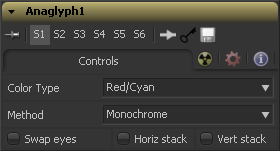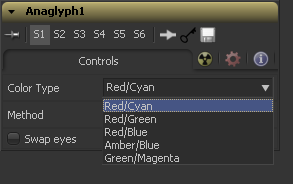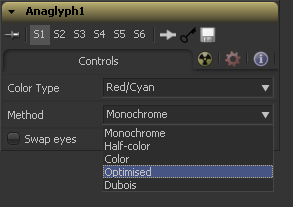Eyeon:Manual/Fusion 6/Anaglyph
From VFXPedia
[ Main Manual Page ]
The Anaglyph tool is used to create stereoscopic images by combining separate left eye and right eye images. It features different methods for that.
It is most commonly used at the end of a stereoscopic workflow to display or deliver the final result.
Controls Tab
When using separate images for the left and right eye, the left eye image is connected to the orange input and the right eye image is connected to the green input of the tool. When using either horizontally or vertically stacked images containing both left- and right information, these only connect to the orange input. Based on one of the methods described below, the separate images are then combined to create a stereoscopic output.
Color Type menu
The ColorType menu allows you to choose between different color encodings
to fit your preferred display device.
To match you stereo glasses you can choose between Red/Cyan, Red/Green, Red/Blue, Amber/Blue and Green/Magenta encoding. Whereas Red/Cyan turns out to be the most commonly used.
Method menu
In addition to the color used for encoding the image you can also choose five different methods. Monochrome, Half-Color, Color, Optimized and Dubois.
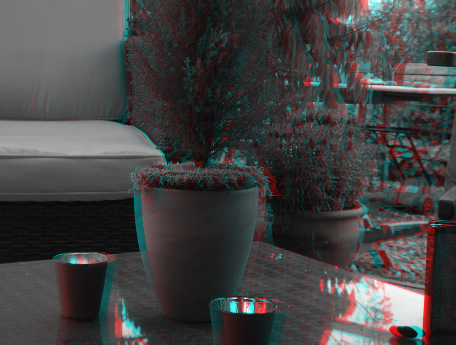
The left eye contains the luminance of the left image, and the right eye contains the luminance of the right image (eg. the luminance of the left image is placed in the output red channel, and the luminance of the right image is placed in the output green and blue channels).
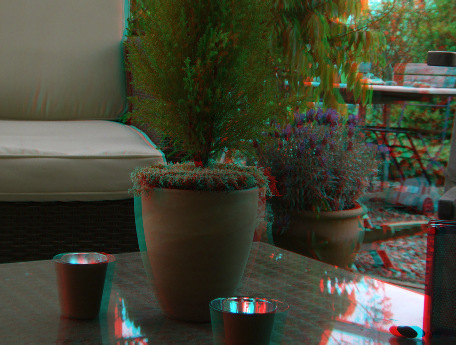
The left eye contains the luminance of the left image, and the right eye contains the colour channels from the right image that match the glasses colour for that eye (eg. the luminance of the left image is placed in the output red channel, and the green and blue channels of the right image are placed in the output green and blue channels).
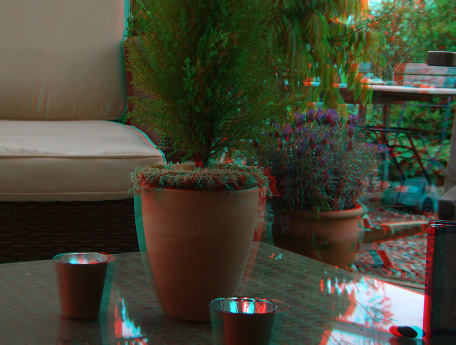
The left eye contains the colour channels from the left image that match the glasses colour for that eye, and the right eye contains the colour channels from the right image that match the glasses colour for that eye (eg. the red channel of the left image is placed in the output red channel, and the green and blue channels of the right image are placed in the output green and blue channels).
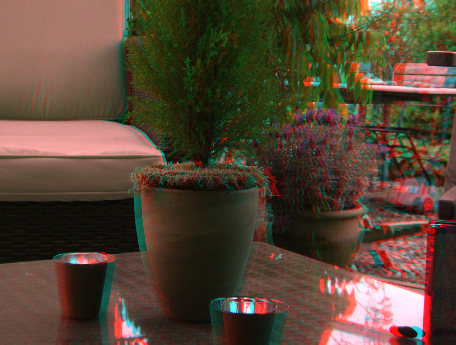
Used with red/cyan glasses for example, the resulting brightness of what shows through the left eye will be substantially less than the brightness of the right eye. Using typical ITU-R 601 ratios for luminance as a guide, the red eye would give 0.299 brightness, while the cyan eye would give 0.587+0.114=0.701 brightness - over twice as bright. The difference in brightness between the eyes can produce what’s referred to as retinal rivalry or binocular rivalry, which can destroy the stereo effect. The Optimised method generates the right eye in the same fashion as the Color method. The left eye also uses the green and blue channels, but in a combination with increased brightness that reduces retinal rivalry. Since it uses the same two channels from each of the source images, it doesn’t reproduce the remaining one (eg. 1.05× the green and 0.45× the blue channels of the left image is placed in the output red channel, and the green and blue channels of the right image are placed in the output green and blue channels. Red from both the left and right images is not used).
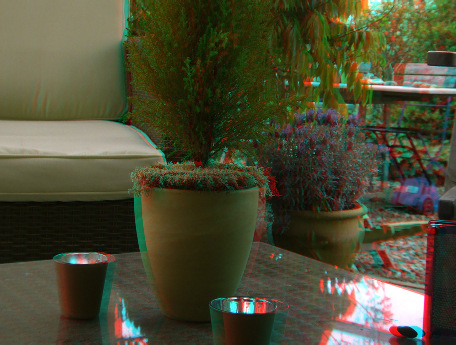
Images with fairly saturated colours can produce retinal rivalry with Half-color, Color and Optimised methods because the colour is only visible in one eye. For example, with red/cyan glasses, a saturated green object looks black in the red eye, and green in the cyan eye. The Dubois method uses the spectral characteristics of (specifically) red/cyan glasses and CRT (Trinitron) phosphors to produce a better anaglyph and in the end tends to reduce retinal rivalry caused by such colour differences in each eye, and also tends to reduce ghosting produced when one eye ‘leaks’ into the other eye. The particular calculated matrix we use is designed for red/cyan glasses and so isn’t available for other glasses types, and since it is also derived from CRT colour primaries, it may not give the best results with a common LCD (though it’ll still likely produces less retinal rivalry and ghosting than the other methods).
Allows to easily swap the left and right eye input.
Takes an image which contains both left- and right-eye information stacked horizontally. These images are often referred to as 'crosseyed' or 'straight stereo' images. You only need to connect that one image to the orange input of the tool. It then creates an image half the width of the original input, using the left half of the original image for the left eye and the right half of the original image for the right eye. Color encoding takes place using the specified color type and method.
Takes an image which contains both left- and right-eye information stacked vertically. You only need to connect that one image to the orange input of the tool. It then creates an image half the height of the original input, using the bottom half of the original image for the left eye and the top half of the original image for the right eye. Color encoding takes place using the specified color type and method.
| The contents of this page are copyright by eyeon Software. |
